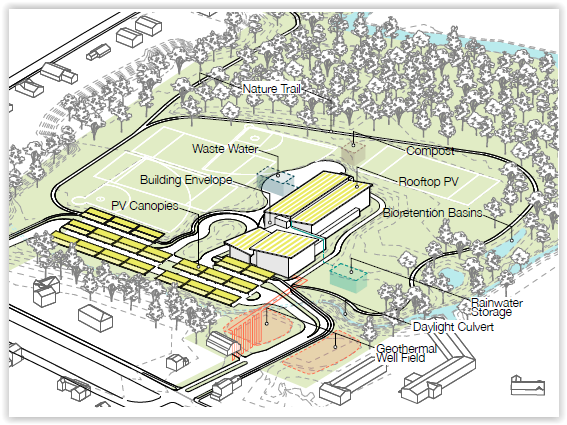Participants At School Building Forum Appear To Favor Fort River Site

DiNisco Design drawing of an approach to sustainability at Fort River. Photo:Amherst Elementary School Building Committee
The Elementary School Building Committee Public Forum about selecting a site for a new elementary school began at 6:38 p.m. on Thursday June 9.
After being introduced, Donna DiNisco, principal of the architecture and planning firm DiNisco Design, reached out and thanked Amherst community members “for all of your participation, being in attendance in many, many, many of these meetings, and your sharing of questions that have really helped us understand what’s most important to you all.”
She noted that a huge and exciting milestone is rapidly approaching — the Elementary School Building Committee (ESBC) will decide on Monday which of four options, which she called solutions, should be brought to the Massachusetts School Building Authority for acceptance. “And,” she announced, “we actually have the evaluation criteria that the building committee will be analyzing and using to come to that preferred solution.” (Those criteria were not made clear during the forum.) She added that later in the forum, participants would be asked “to let us know what’s important to you as we start looking at ranking the criteria for the preferred solution.”
Unfortunately, there was a long hiatus while a technical problem involving two Zoom links having been published, one of which was not “live.” Resident Pat Onanibaku suggested that it might be appropriate to reschedule the public forum if residents were unable to log in, but when the problem was resolved, the meeting continued from where it had left off, with a discussion of the four basic options: renovate and expand the Fort River school, or build a new school on the Fort River site; renovate and expand the Wildwood school, or build a new school on the Wildwood site. This was followed by a shower of details and data concerning, but not explaining, things like drive aisles, trunk streets, slopes, water levels, profile lines, geothermal well fields, fence lines to push. The public barely responded.
Town Councilor Pam Rooney, however, opened a topic that had not been addressed: little or no outdoor play space at the Wildwood site during the years-long construction period. She expressed concern about children being indoors for seven semesters during construction and its affects on the mental health of the children, faculty, and others.
“Doug” (last name not known at press time) suggested that the primary differences between the school sites, given that both have high water levels, are their sizes and the provisions needed to accommodate their conditions. Like Rooney, he expressed concern that there would be very little space at the Wildwood site for children to go outside during the construction period, and noted that Fort River’s large site has useable acreage for playing fields even during construction. He responded to statements that the Fort River site price tag would be higher than Wildwood’s, saying that more space is a benefit although it entails higher expenditure. “The larger site at Fort River that gives you the playing fields during construction comes at a higher cost because there’s just more site to deal with.”
In response to a question about whether it would be possible for the Wildwood school children to use middle school fields during construction, DiNisco said that this would add to the cost of the Wildwood site, which would be difficult and costly to access, in part because of terrain issues. “That field, and that whole area, is wet,” she added, “so we would want to improve it if it’s going to be used.”
Resident Irene Dujove pointed out that cost comparisons between the two sites should be “apples to apples,” and that significant potential benefits offered by each site, such as the Fort River site’s acreage, should be taken into account.
Soon after, participants were asked to fill out an internet survey ranking the priority levels of six specific aspects of the new school. The resulting ranking of priorities, among the choices given, is:
1) [Provides] Outdoor space for play and education
2) Minimizes construction impact on students
3) Optimizes energy efficiency
4) Minimizes construction duration
5) Total cost
6) Maximizes efficient use of the site
Driving routes between North Amherst and East Amherst were discussed briefly and ample time was provided for members of the public to comment before the forum ended at about 8:30 p.m.

Have the architects read their maps wrong?
The illustration of the buildings with rooftop PV shows them sloping to the NORTH!
That would be fine in Argentina, but not so in Amherst 🙂
[Details, details….]